Spatial and Temporal Variation Characteristics of Snowfall in the Haihe River Basin from 1960 to 2016
Abstract
:1. Introduction
2. Overview of the Study Area
3. Data Sources and Methods
3.1. Data Sources
3.2. Clustering Methods and Partitioning
3.3. Research Methods
3.3.1. Snowfall Identification Method
3.3.2. Mann–Kendall Trend Test Method
3.4. Snowfall Index
4. Results
4.1. Snowfall Identification and Verification
4.2. Spatial Distribution Characteristics of Snowfall and the Number of Snowfall Days at Different Levels
4.3. Interannual Variation Trends in Snowfall and Number of Snowfall Days at Different Levels
4.4. Response of Snowfall to Climate Change
4.4.1. Changes in Temperature during Snowstorms and Other Snowfall Events
4.4.2. Relationship between Snowfall Intensity and Temperature
5. Discussion
6. Conclusions
Author Contributions
Funding
Institutional Review Board Statement
Informed Consent Statement
Data Availability Statement
Acknowledgments
Conflicts of Interest
References
- Wang, J.; Li, S. Effects of climate change on snowfall melt runoff in China’s inland arid mountains. Sci. China Earth Sci. 2005, 35, 664–670. [Google Scholar]
- Li, X. Variation Characteristics of Snowfall in Xinjiang from 1961 to 2010. Master’s Thesis, Northwest Normal University, Lanzhou, China, 2013. [Google Scholar]
- Qin, Y.; Ding, J. Analysis on variation characteristics of snowfall events of different levels in Tianshan, China from 1961 to 2016. Adv. Water Sci. 2019, 30, 457–466. [Google Scholar]
- Hahn, D.G.; Shukla, J. An apparent relationship between Eurasian snowfall cover and Indian monsoon rainfall. J. Atmos. Sci. 1976, 33, 2461–2462. [Google Scholar] [CrossRef] [Green Version]
- Yamazaki, K. A study of the impact of soil moisture and surface bed of changes on global climate using the MRI GCM-I. J. Meteorol. Soc. Jpn. 1989, 67, 123–146. [Google Scholar] [CrossRef] [Green Version]
- Zhang, Z.; Xi, S.; Liu, N.; Yu, Y.; Fan, S.; Feng, M. Analysis on spatiotemporal variation characteristics of snowfall in China from 1961 to 2012. Resour. Sci. 2015, 37, 1765–1773. [Google Scholar]
- Lin, Z. Topographic Precipitation Climatology; Science Press: Beijing, China, 1995; pp. 147–148. [Google Scholar]
- Barnett, T.P.; Dumenil, L.; Schlese, U.; Roeckner, E. The effect of Eurasian snow cover on global climate. Science 1988, 239, 504–507. [Google Scholar] [CrossRef]
- Cohen, J.; Rind, R. The effect of snowfall cover on the climate. J. Clim. 1991, 4, 689–706. [Google Scholar] [CrossRef]
- Namias, J. Some empirical evidence for the influence of snow covers on temperature and precipitation. Mon. Weather. Rev. 1985, 113, 1542–1543. [Google Scholar] [CrossRef] [Green Version]
- Vernekar, A.D.; Zhou, J.; Shukla, J. The effect of Eurasian snowfall cover on the Indian monsoon. J. Clim. 1995, 8, 248–266. [Google Scholar] [CrossRef] [Green Version]
- Wu, M.; Zhao, X.; Liu, W.; Zhang, L.; He, L. Characteristics of hydrothermal conditions in winter of 2017/2018 and influence on agricultural production. Chin. J. Agrometeorol. 2008, 39, 66–68. [Google Scholar]
- Shen, Y.; Su, H.; Wang, G.; Mao, W.; Wang, S.; Han, P.; Wang, N.; Li, Z. Response of glaciers and snowfall cover to Climate change in Xinjiang: II: Disaster effect. J. Glaciol. Geocryol. 2013, 35, 1355–1370. [Google Scholar]
- Guo, L.; Li, L. Variation of the proportion of precipitation occurring as snow in the Tian Shan Mountains, China. Int. J. Climatol. 2015, 35, 1379–1393. [Google Scholar] [CrossRef]
- Wang, Y.; Liu, X.; Bai, A.; Qi, D.; Xiao, H.; Ou, J. Analysis on variation characteristics of extreme snowfall index in Sanjiangyuan region from 1961 to 2017. J. Meteorol. Environ. 2008, 34, 108–115. [Google Scholar]
- Zhang, L.; Zhang, J.; Li, J. Analysis on variation characteristics of extreme snowfall events in winter in Altay Prefecture. J. Arid Land Resour. Environ. 2014, 28, 89–95. [Google Scholar]
- Yao, T.; Qin, D.; Shen, Y.; Zhao, L.; Wang, N.; Lu, A. Changes in cryosphere of Qinghai-Tibet Plateau and influence on regional water cycle and ecological conditions. Chin. J. Nat. 2013, 35, 179–186. [Google Scholar]
- Donat, M.G.; Lowry, A.L.; Alexander, L.V.; O’Gorman, P.A.; Maher, N. More extreme precipitation in the world’s dry and wet regions. Nat. Clim. Change 2016, 6, 508–513. [Google Scholar] [CrossRef]
- Li, B. Analysis on Spatial and Temporal Variation of Precipitation and Snowfall Impact Factor Analysis in Northeast China in Recent 50 Years. Master’s Thesis, Lanzhou University, Lanzhou, China, 2013. [Google Scholar]
- Huang, Y. Influence of Climate Warming on Spatial and Temporal Variation of Snowfall in Heilongjiang Province. Master’s Thesis, Harbin Normal University, Harbin, China, 2019. [Google Scholar]
- Vries, H.D.; Haarsma, R.J.; Hazeleger, W. On the future reduction of snowfall in western and central Europe. Clim. Dyn. 2013, 41, 2319–2330. [Google Scholar] [CrossRef]
- Vries, H.D.; Lenderink, G.; Meijgaard, E.V. Future snowfall in western and central Europe projected with a high-resolution regional climate model ensemble. Geophys. Res. Lett. 2014, 41, 4294–4299. [Google Scholar] [CrossRef]
- Bintanja, R. The impact of Arctic warming on increased rainfall. Sci. Rep. 2018, 8, 16001. [Google Scholar] [CrossRef] [Green Version]
- Jiang, W.; Xia, L.; Xiao, T.; Luo, B.; Zhou, Z. Climate change and spatial distribution of winter snowfall in Qinghai-Tibet Plateau from 1971 to 2010. J. Glaciol. Geocryol. 2016, 38, 1211–1218. [Google Scholar]
- Tunyaz, N.; Mamat, B.; Zhang, Y. Analysis on spatial and temporal distribution characteristics and mutation of snowfall in western Southern Xinjiang. Arid Zone Res. 2016, 33, 934–942. [Google Scholar]
- Xu, J.; Qiu, J. Research on snowfall fluctuation in Tianshan Mountains in the past 30 years. J. Glaciol. Geocryol. 1996, S1, 123–128. [Google Scholar]
- Li, X.; Zhang, M.; Wang, B.; Wang, Y.; Wang, S. Variation characteristics of snowfall, concentration degree and concentration period in winter in Tianshan region. Resour. Sci. 2012, 34, 1556–1564. [Google Scholar]
- Mishra, A.K.; Rafiq, M. Analyzing snowfall variability over two locations in kashmir, india in the context of warming climate. Dyn. Atmos. Oceans 2017, 79, 1–9. [Google Scholar] [CrossRef]
- Huntington, T.G.; Hodgkins, G.A.; Keim, B.D.; Dudley, R.W. Changes in the proportion of precipitation occurring as snow in New England (1949–2000). J. Clim. 2004, 17, 2626–2636. [Google Scholar] [CrossRef]
- Irannezhad, M.; Ronkanen, A.K.; Kiani, S.; Chen, D.; Kløve, B. Long-term variability and trends in annual snowfall/total precipitation ratio in Finland and the role of atmospheric circulation patterns. Cold Reg. Sci. Technol. 2017, 143, 23–31. [Google Scholar] [CrossRef]
- Räisänen, J. Twenty-first century changes in snowfall climate in Northern Europe in ENSEMBLES regional climate models. Clim. Dyn. 2015, 46, 339–353. [Google Scholar] [CrossRef] [Green Version]
- Lute, A.C.; Abatzoglou, J.T.; Hegewisch, K.C. Projected changes in snowfall extremes and interannual variability of snowfall in the western U.S. Water Resour. Res. 2015, 51, 960–972. [Google Scholar] [CrossRef]
- Ning, L.; Bradley, R.S. Snowfall occurrence changes over the central and eastern United States under future warming scenarios. Sci. Rep. 2015, 5, 17073. [Google Scholar] [CrossRef] [Green Version]
- Zhao, C.; Wang, J.; Yan, X.; Wang, Y.; Luo, Y. Climate characteristics and division of winter snowfall in northeast China. J. Nat. Disasters 2009, 18, 29–35. [Google Scholar]
- Skoulikaris, C.; Anagnostopoulou, C.; Lazoglou, G. Hydrological modeling response to climate model spatial analysis of a south eastern Europe international basin. Climate 2020, 8, 1. [Google Scholar] [CrossRef] [Green Version]
- Yang, Z.L.; Dickinson, R.E.; Robock, A.; Vinnikov, K.Y. Validation of the snowfall submodel of the biosphere-atmosphere transfer scheme with Russian snowfall cover and meteorological observational data. J. Clim. 1997, 10, 353–373. [Google Scholar] [CrossRef]
- Zhang, Z.; Wang, Z. Research on identification criterion of precipitation phase state in Hohhot. Inner Mongolia For. Sci. Technol. 2017, 43, 42–47. [Google Scholar]
- Dai, A. Temperature and pressure dependence of the rain-snowfall phase transition over land and ocean. Geophys. Res. Lett. 2008, 35, 62–77. [Google Scholar] [CrossRef]
- Jennings, K.S.; Molotch, N.P. The sensitivity of modeled snow accumulation and melt to precipitation phase methods across a climatic gradient. Hydrol. Earth Syst. Sci. 2019, 23, 3765–3786. [Google Scholar] [CrossRef] [Green Version]
- Jennings, K.S.; Winchell, T.S.; Livneh, B.; Molotch, N.P. Spatial variation of the rain–snow temperature threshold across the northern hemisphere. Nat Commun. 2018, 9, 1148. [Google Scholar] [CrossRef] [Green Version]
- Harpold, A.A.; Kaplan, M.L.; Klos, P.Z.; Link, T.; McNamara, J.P.; Rajagopal, S.; Schumer, R.; Steele, C.M. Rain or snow: Hydrologic processes, observations, prediction, and research needs. Hydrol. Earth Syst. Sci. 2017, 21, 1–22. [Google Scholar] [CrossRef] [Green Version]
- Marks, D.; Winstral, A.; Reba, M.; Pomeroy, J.; Kumar, M. An evaluation of methods for determining during-storm precipitation phase and the rain/snow transition elevation at the surface in a mountain basin. Adv. Water Resour. 2013, 55, 98–110. [Google Scholar] [CrossRef]
- Ye, H.; Cohen, J.; Rawlins, M. Discrimination of solid from liquid precipitation over northern Eurasia using surface atmospheric conditions. J. Hydrometeorol. 2013, 14, 1345–1355. [Google Scholar] [CrossRef] [Green Version]
- Matsuo, T.; Sato, Y.; Sasyo, Y. Relationship between types of precipitation on the ground and surface meteorological elements. J. Meteorol. Soc. Jpn. 1981, 59, 462–475. [Google Scholar] [CrossRef] [Green Version]
- Chen, R.; Lv, S.; Kang, E.; Ji, X.; Zhang, Z.; Yang, Y.; Qing, W. A distributed water-heat coupled model for mountainous watershed of an inland river basin of Northwest China (I) model structure and equations. Environ. Geol. 2008, 53, 1299–1309. [Google Scholar] [CrossRef]
- Liu, S.; Yan, D.; Wang, H.; Qin, T.; Weng, B.; Li, Y. Snowfall identification and evolution trend and cause analysis in the upper reaches of the Nu River. J. Hydraul. Eng. 2018, 49, 254–262. [Google Scholar]
- Feiccabrino, J.; Graff, W.; Lundberg, A.; Sandström, N.; Gustafsson, D. Meteorological knowledge useful for the improvement of snow rain separation in surface based models. Hydrology 2015, 2, 266–288. [Google Scholar] [CrossRef] [Green Version]
- Wang, G.; Yan, D.; Zhang, D.; Liu, S. Analysis on variation trend of extreme temperature and precipitation in Haihe River Basin from 1961 to 2010. South-to-North Water Divers. Water Conserv. Sci. Technol. 2014, 12, 1–6. [Google Scholar]
- Shao, Y.; Liu, L.; Liu, J.; Wu, J. Frequency analysis and spatial and temporal distribution characteristics of precipitation extremum closing to 60a in Haihe River Basin. Trans. Atmos. Sci. 2020, 43, 381–391. [Google Scholar]
- Ma, M.; Han, Y.; Wang, Q.; Zhao, Y.; Wang, J. Spatial and temporal variation of extreme precipitation in Haihe River Basin and relationship with atmospheric circulation. Int. J. Hydroelectr. Energy 2019, 37, 1–4. [Google Scholar]
- Liu, X.; Ren, G.; Fan, Z.; Zhang, C.; Yang, X. Analysis on spatial and temporal variation trend of extreme heavy precipitation in Haihe River Basin in recent 47 years. J. Arid Land Resour. Environ. 2010, 24, 85–90. [Google Scholar]
- Wei, Z. Study on Variation of Underlying Surface Elements in the Haihe River Basin and Its Impact on Flood. Ph.D Thesis, Tianjin University, Tianjin, China, 2013. [Google Scholar]
- Wang, F.; Zhu, Z.; Hao, X.; Han, D.; Wang, H.; Wang, Q. Research on snowfall identification and evolution trend in Xilin River Basin. Plateau Meteorol. 2019, 38, 725–733. [Google Scholar]
- Zhang, L.; Wu, S.; Dong, F. Research on identification criterion of precipitation phase state in Anqing. J. Meteorol. Environ. 2008, 34, 30–37. [Google Scholar]
- Mann, H.B. Non-parametric tests against trend. Econometrica 1945, 13, 245–259. [Google Scholar] [CrossRef]
- Kendall, M.G. Rank Correlation Measures; Charles Griffin: London, UK, 1975. [Google Scholar]
- Kottegoda, N.T. Stochastic Water Resources Technology; Wiley: New York, NY, USA, 1980; ISBN 978-1-349-03467-3. [Google Scholar]
- Burn, D.H.; Elnur, M.A.H. Detection of hydrologic trends and variability. J. Hydrol. 2002, 55, 107–122. [Google Scholar] [CrossRef]
- Aziz, O.I.A.; Burn, D.H. Trends and variability in the hydrological regime of the Mackenzie River Basin. J. Hydrol. 2006, 319, 282–294. [Google Scholar] [CrossRef]
- Mishra, A.K.; Singh, V.P. Changes in extreme precipitation in Texas. J. Geophys. Res. Atmos. 2010, 115, D14. [Google Scholar] [CrossRef]
- Sun, X.; Luo, Y.; Zhang, X.; Gao, Y. Analysis on variation characteristics of snowfall in China in recent 46 years. Plateau Meteorol. 2010, 29, 1594–1601. [Google Scholar]
- Liu, Y.; Ren, G.; Yu, H. Characteristics of snowfall climatology in China. Geogr. Sci. 2012, 10, 19–28. [Google Scholar]
- Sun, X.; Sun, Z.; Luo, Y. Study on variation characteristics of snowfall in northeast China from 1960 to 2005. J. Meteorol. Environ. 2010, 226, 1–5. [Google Scholar]
- Li, P. Preliminary study on change of snowfall in China in recent 30 years. Acta Meteorol. Sin. 1990, 4, 51–55. [Google Scholar]
- Li, S.; Chen, L.; Ren, Y. Study on changes of winter precipitation in China from 1951/1952 to 2004/2005. J. Trop. Meteorol. 2008, 24, 94–98. [Google Scholar]
- Xu, X. Variation and regional distribution characteristics of snowfall in China from 1970 to 2000. J. Glaciol. Geocryol. 2011, 3, 41–47. [Google Scholar]
- Zhang, H.; Chen, Y.; Yang, M. Climatological data uniformity test and climate change trend analysis of Mount Wutai station. Chin. Agric. Sci. Bull. 2016, 32, 168–173. [Google Scholar]
- Yang, H.; Yang, D.; Lei, Z. Effects of topographic rain reduction on water resources in Mount Wutai. Adv. Water Sci. 2010, 21, 674–680. [Google Scholar]
- Jones, R.; Westra, S.; Sharma, A. Observed relationships between extreme sub-daily precipitation surface temperature and relative humidity. Geophys. Res. Lett. 2011, 37, 22805–22810. [Google Scholar]

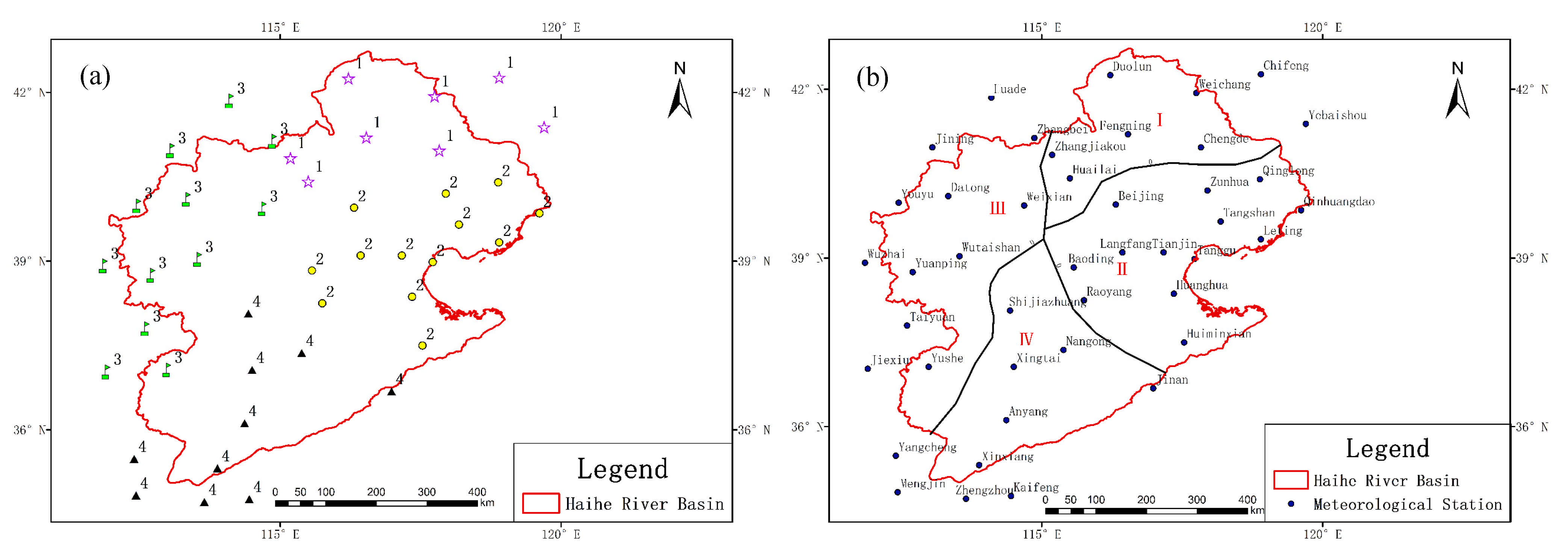
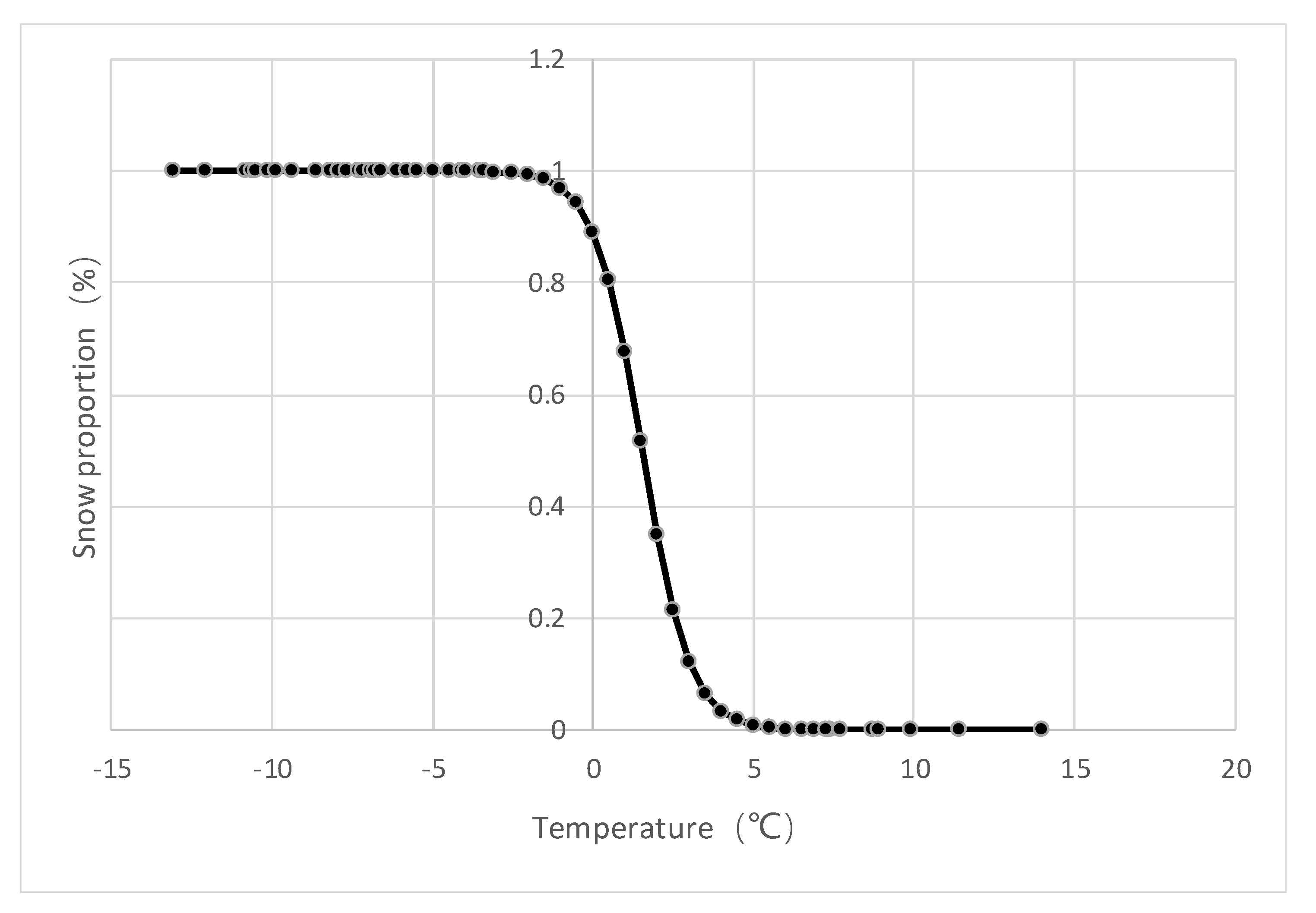
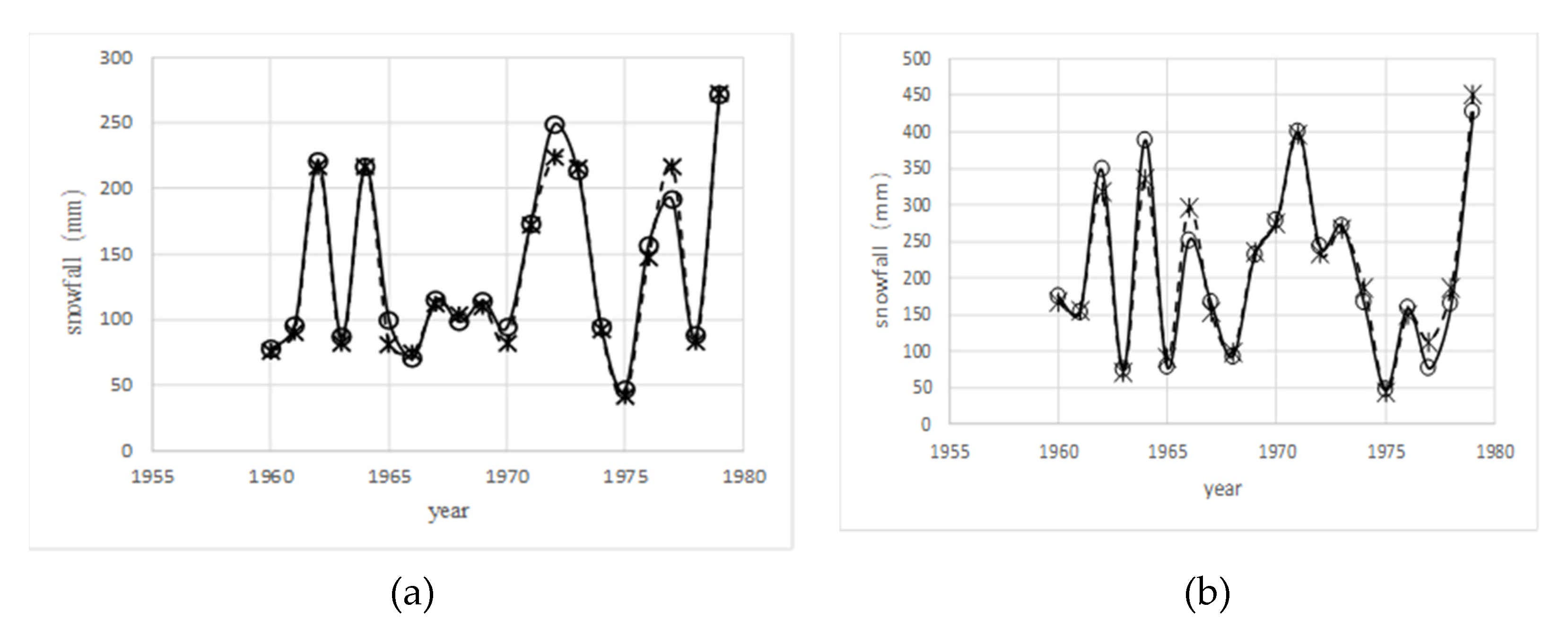
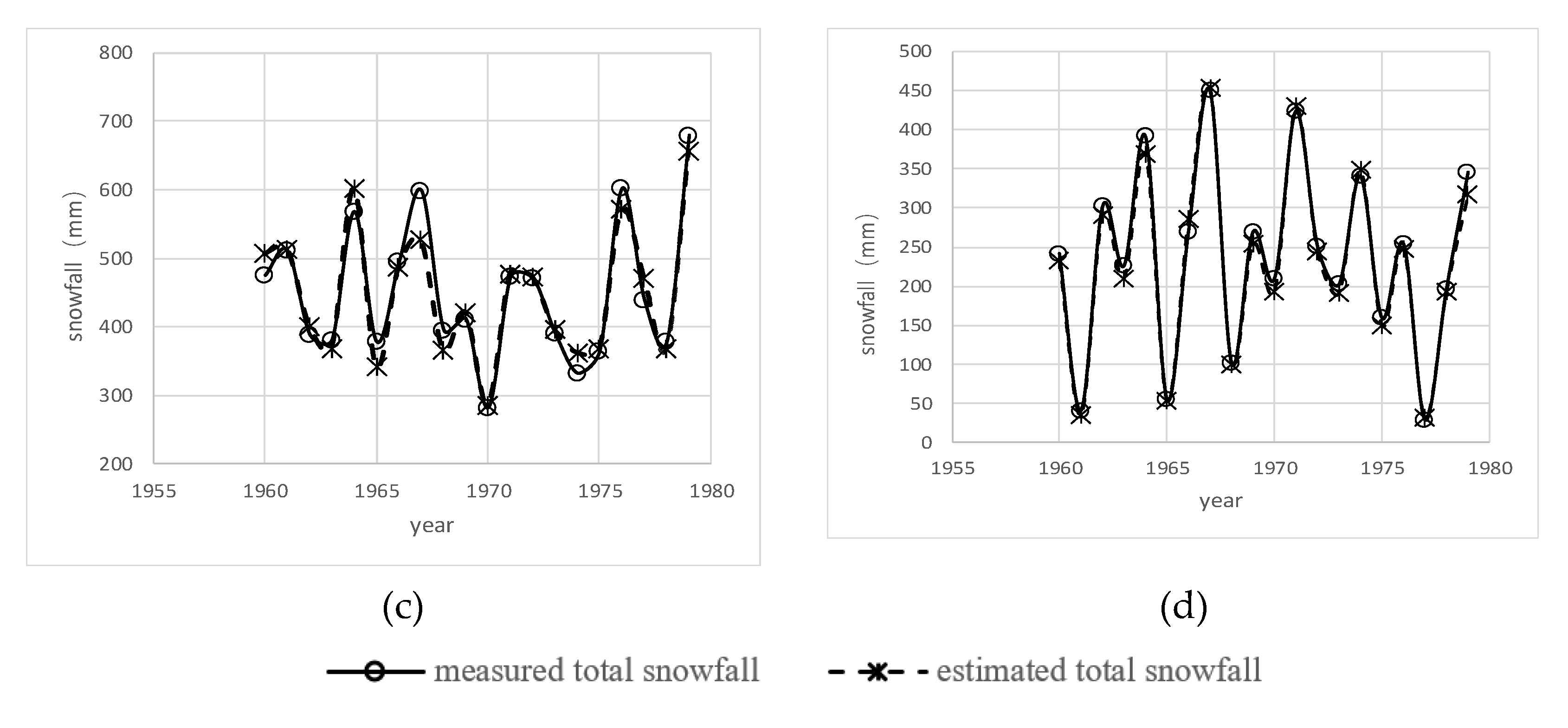
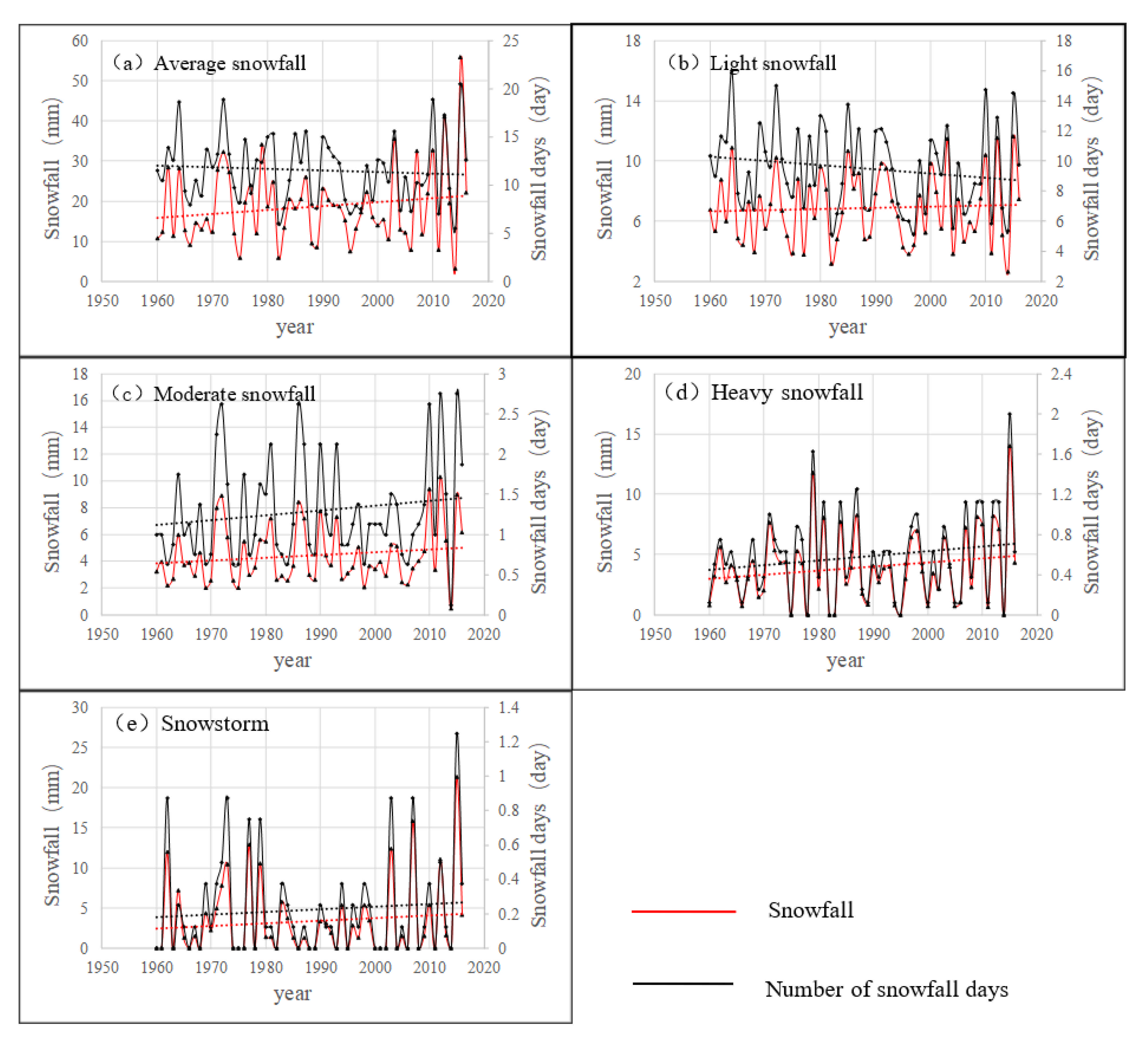


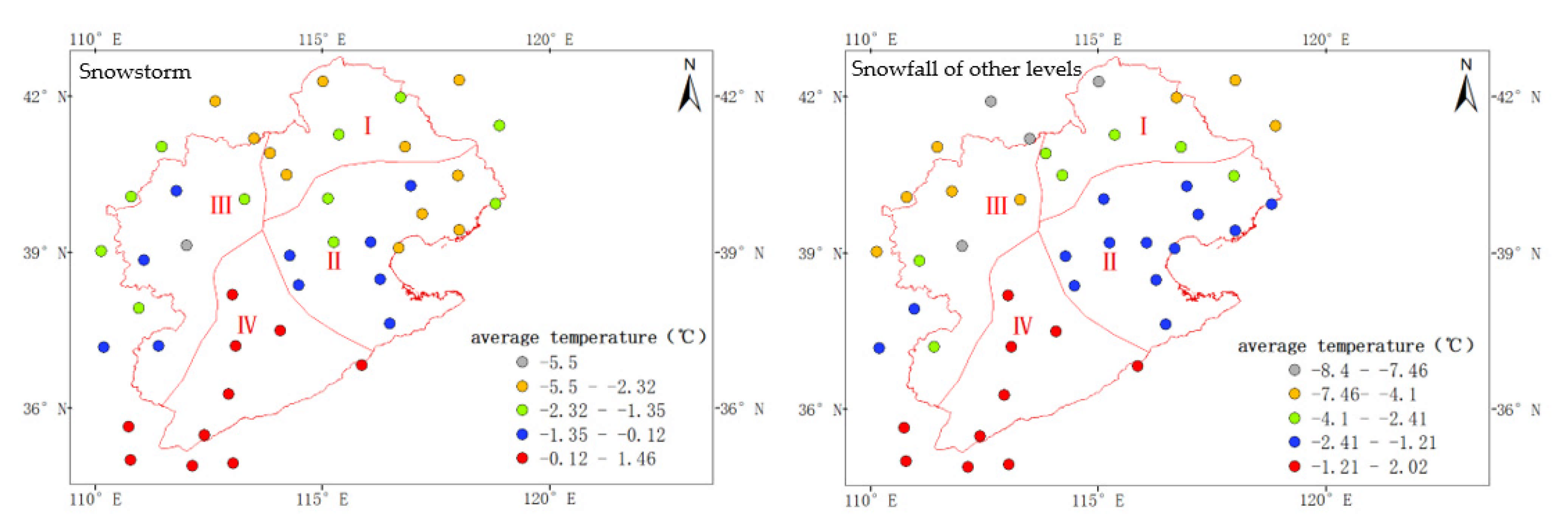
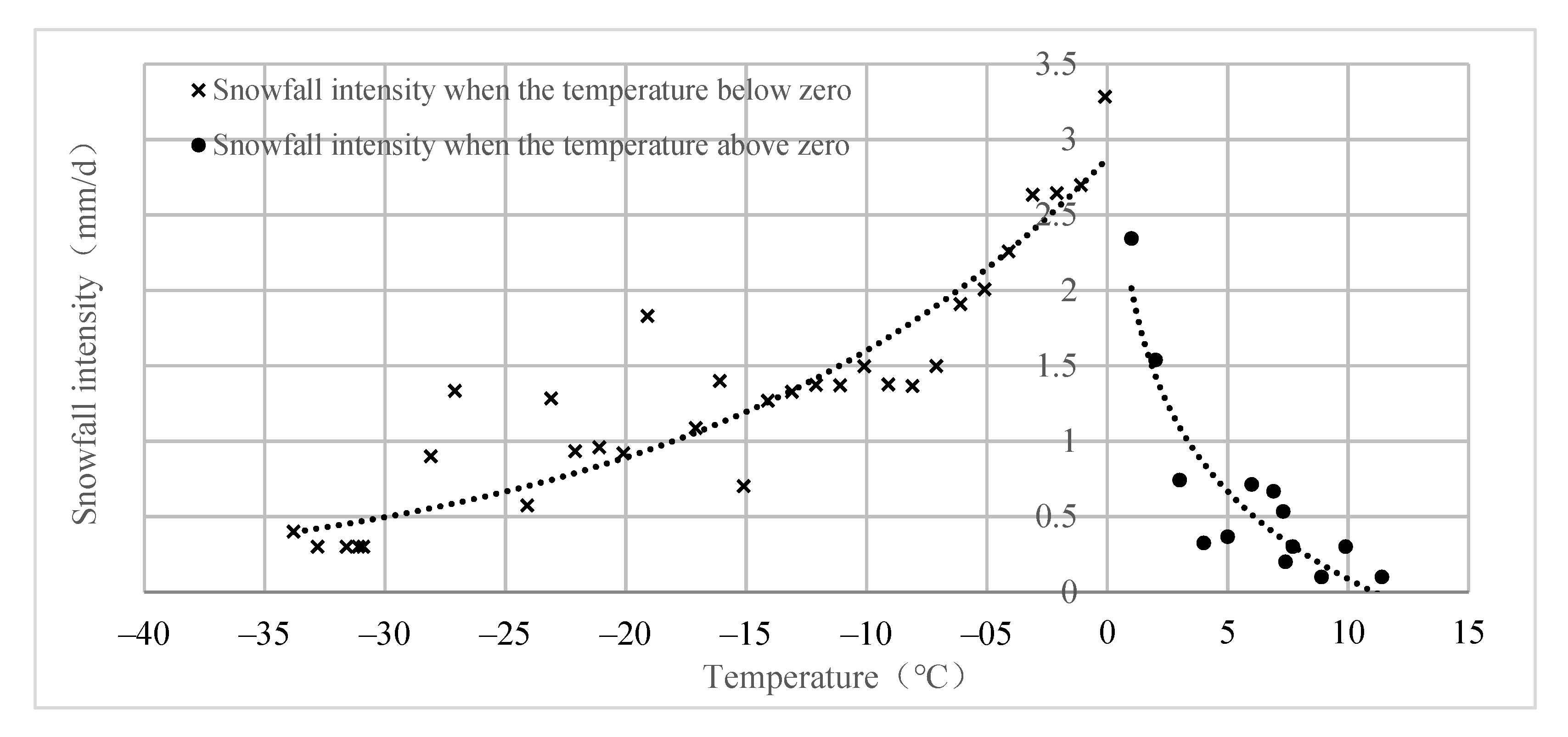
| Zone | Climate Type | Elevation (m) | Average Annual Snowfall (mm) | Average Annual Temperature (°C) | Number of Meteorological Stations | Proportion of Meteorological Stations (%) |
|---|---|---|---|---|---|---|
| I | Temperate continental monsoon climate | 375.2–1245.4 | 18.6 | 7.3 | 8 | 19 |
| II | Temperate monsoon climate | 1.8–227.2 | 14.5 | 11.9 | 13 | 30 |
| III | Temperate continental monsoon climate | 748.8–2895.8 | 36.9 | 6.0 | 12 | 28 |
| IV | Temperate monsoon climate | 27.4–659.5 | 22.7 | 13.9 | 10 | 23 |
| Indicator | Definition |
|---|---|
| Light snow | 0.1 mm < daily snowfall < 2.5 mm |
| Moderate snow | 2.5 mm ≤ daily snowfall < 5 mm |
| Heavy snow | 5 mm ≤ daily snowfall < 10 mm |
| Snowstorm | daily snowfall ≥ 10 mm |
| Zone | Calibration Period (1960–1969) | Validation Period (1970–1979) | ||
|---|---|---|---|---|
| Correlation Coefficient | Relative Error (%) | Correlation Coefficient | Relative Error (%) | |
| I | 0.99 | −2.99 | 0.98 | −3.39 |
| II | 0.97 | 0.14 | 0.99 | 4.82 |
| III | 0.93 | −1.52 | 0.95 | 0.99 |
| IV | 0.98 | −3.53 | 0.98 | −1.83 |
| Zone | Indicator | Light Snow | Moderate Snow | Heavy Snow | Snowstorm |
|---|---|---|---|---|---|
| I | Snowfall (mm) | 6.9 | 4.5 | 3.9 | 3.4 |
| Proportion of snowfall (%) | 36.90 | 23.92 | 21.05 | 18.13 | |
| Snowfall days (d) | 9.5 | 1.3 | 0.6 | 0.2 | |
| Proportion of number of snowfall days (%) | 81.98 | 11.10 | 4.98 | 1.93 | |
| II | Snowfall (mm) | 4.8 | 3.8 | 3.6 | 2.4 |
| Proportion of snowfall (%) | 33.05 | 25.94 | 24.41 | 16.60 | |
| Snowfall days (d) | 6.2 | 1.1 | 0.5 | 0.2 | |
| Proportion of number of snowfall days (%) | 77.64 | 13.77 | 6.50 | 2.09 | |
| III | Snowfall (mm) | 11.3 | 8.7 | 8.7 | 8.3 |
| Proportion of snowfall (%) | 30.65 | 23.55 | 23.41 | 22.39 | |
| Snowfall days (d) | 14.6 | 2.5 | 1.3 | 0.6 | |
| Proportion of number of snowfall days (%) | 77.27 | 13.10 | 6.72 | 2.90 | |
| IV | Snowfall (mm) | 5.4 | 5.3 | 6.5 | 5.5 |
| Proportion of snowfall (%) | 23.75 | 23.50 | 28.68 | 24.07 | |
| Snowfall days (d) | 6.7 | 1.5 | 0.9 | 0.4 | |
| Proportion of number of snowfall days (%) | 70.51 | 15.86 | 9.77 | 3.85 |
| Level | I | II | III | IV | |
|---|---|---|---|---|---|
| Light Snow | Snowfall (mm/10 a) | 0.080 | −0.158 | −0.436 | −0.014 |
| Number of Snowfall Days (d/10 a) | −0.279 | −0.296 | −0.948 | −0.039 | |
| Moderate Snow | Snowfall (mm/10 a) | 0.206 | 0.085 | −0.927 | −0.067 |
| Number of Snowfall Days (d/10 a) | 0.061 | 0.017 | −0.262 | −0.020 | |
| Heavy Snow | Snowfall (mm/10 a) | 0.341 | −0.200 | −0.995 | −0.045 |
| Number of Snowfall Days (d/10 a) | 0.047 | −0.030 | −0.154 | −0.002 | |
| Snowstorm | Snowfall (mm/10 a) | 0.327 | −0.072 | −0.944 | 0.038 |
| Number of Snowfall Days (d/10 a) | 0.016 | −0.030 | −0.058 | −0.018 | |
| Average | Snowfall (mm/10 a) | 0.954 | −0.354 | −3.300 | −0.088 |
| Number of Snowfall Days (d/10 a) | −0.156 | −0.319 | −1.420 | −0.080 | |
Publisher’s Note: MDPI stays neutral with regard to jurisdictional claims in published maps and institutional affiliations. |
© 2021 by the authors. Licensee MDPI, Basel, Switzerland. This article is an open access article distributed under the terms and conditions of the Creative Commons Attribution (CC BY) license (https://creativecommons.org/licenses/by/4.0/).
Share and Cite
Wu, X.; Li, S.; Liu, B.; Xu, D. Spatial and Temporal Variation Characteristics of Snowfall in the Haihe River Basin from 1960 to 2016. Water 2021, 13, 1798. https://doi.org/10.3390/w13131798
Wu X, Li S, Liu B, Xu D. Spatial and Temporal Variation Characteristics of Snowfall in the Haihe River Basin from 1960 to 2016. Water. 2021; 13(13):1798. https://doi.org/10.3390/w13131798
Chicago/Turabian StyleWu, Xu, Su Li, Bin Liu, and Dan Xu. 2021. "Spatial and Temporal Variation Characteristics of Snowfall in the Haihe River Basin from 1960 to 2016" Water 13, no. 13: 1798. https://doi.org/10.3390/w13131798
APA StyleWu, X., Li, S., Liu, B., & Xu, D. (2021). Spatial and Temporal Variation Characteristics of Snowfall in the Haihe River Basin from 1960 to 2016. Water, 13(13), 1798. https://doi.org/10.3390/w13131798






